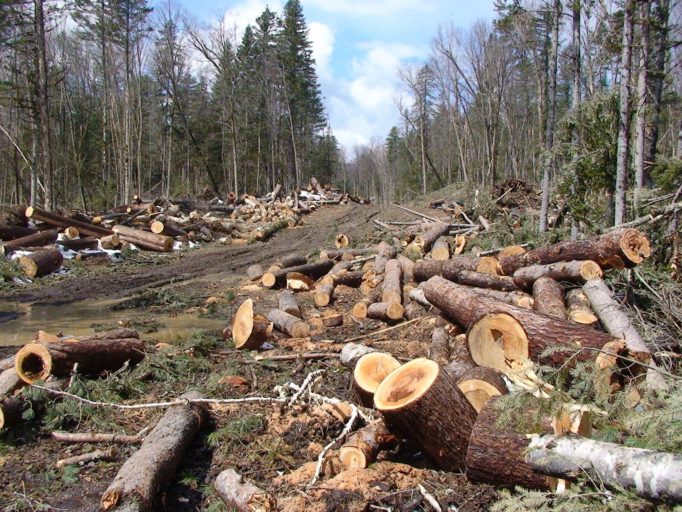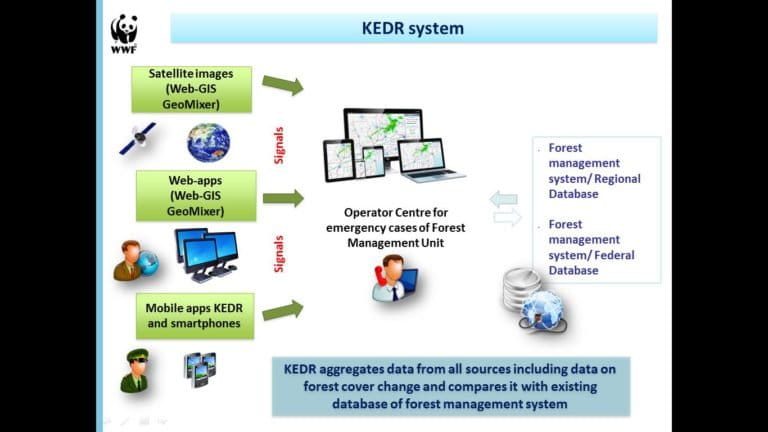- KEDR uses an algorithm to automatically analyze real-time satellite images for various canopy changes to provide forest managers precise logging intelligence so they can quickly counteract violations.
- The technology could help conserve the critically endangered Amur tiger and leopard that inhabit these forests.
- KEDR is now being implemented in two provinces and has been recommended for use throughout the country. The tool will continue to be developed with technological upgrades, high-precision satellite imagery, new algorithms and artificial intelligence.
The destruction of temperate forests in the Russian Far East is a major threat to the iconic yet critically endangered Amur tigers and leopards; their fate depends on the curbing of illegal logging, which drives deforestation in this region. A pioneering forest monitoring system called KEDR is now harnessing remote sensing to aid this conservation effort.

Developed by a group of organizations led by the World Wildlife Fund (WWF)-Russia’s Amur Branch, KEDR uses an algorithm to automatically analyze medium-resolution satellite images relayed to the control station in real-time. It detects various changes in forest canopy and compares them to the boundaries of authorized harvesting areas to identify violations. In this way, forest managers in the KEDR monitoring dispatching center get up-to-date information intelligence about logging activity and can swiftly identify and counteract violations.
“KEDR opens up opportunities for successful implementation of information technologies in forest management and for general improvement of the industry,” said WWF Russia.
The conservationists named the remote monitoring system after the most biodiverse Russian forest, the cedar-broadleaf forest they seek to protect from the illegal logging that threatens its plant and endemic animal species.
“KEDR [is] CEDAR in Russian, a commonly used name for Korean pine,” said Andrey Purekhovsky, Dmitriy Sychikov and Nikolay Shmatkov of WWF Russia’s Amur division. “[It] is a source of pine-nuts and perhaps the most important tree species for the diversity and productivity of unique high conservation value forests in the south of [the] Russian Far East, home for the Amur tiger and Far Eastern leopard.”

Piloting KEDR
During three meetings at the Office of the Presidential Representative in the Far Eastern Federal District, the conservationists introduced KEDR to provincial officials, allowing them to scrutinize its implementation. In July 2015, they decided to test KEDR in the field. In August and September of that year, GIS specialists from WWF Russia Amur Branch and staff from the Primorsky and Khabarovsky Forest Management Departments tried KEDR out in temperate mixed forest units in the provinces of Primorsky and Khabarovsky. They confirmed 83 out of 105 of the canopy changes the system identified, meaning its algorithm was roughly 80% accurate. The technology also identified over half of all logging-related alterations in the canopy. The field study helped discover 11 cases of illegal logging and confiscate equipment used in these operations.
The KEDR implementers presented these results at the final meeting of the Presidential Representative to the Far Eastern Federal District, which took place in Khabarovsk the following October. Representatives from federal and regional forest agencies affirmed KEDR’s effectiveness in identifying illegal logging sites and mandated forest managers to implement it in the Primorsky and Khabarovsky provinces.
“At the moment the majority of professionals have no doubt in ‘KEDR’ effectiveness,” said Sychikov, forest project coordinator at WWF Russia’s Amur branch.

How the technology works
KEDR can pick up changes in canopy cover as small as 10-50 sq m, or 0.02-0.4 Ha. According to Sychikov, it’s critical to detect illegal logging sites, which tend to be small in area. KEDR accurately registers logging sites as small as 0.45 Ha—the size of a football field—and helped find an illegal one measuring 64 sq m—the size of a three-room apartment. The tool is so acute that, in multiple instances, it even detected the logging of a single tree.
The system generates alerts pertaining to forest cover change through the GLAD (Global Land Analysis and Discovery) algorithm, formulated by Dr. Matthew Hansen’s team at the University of Maryland. Using a matrix-based analysis, the algorithm stores and examines the pixel data in open-access multispectral Landsat and Sentinel images of the canopy to identify alterations with great precision. Because illegal logging is difficult to differentiate from natural tree loss, KEDR also incorporates additional information—forest taxa, high-resolution satellite images, data from drones and signals sent by rangers on the ground—to tell various kinds of canopy change apart.
KEDR also expands the conservation process beyond forest managers’ hands. Anyone can download the mobile application to a smartphone or tablet and use it to report violations to the control station.
“Crowdsourcing can play a critical role in controlling for corruption and ineffectiveness of public officials, should they decide to ignore the signals on illegal logging. Public control, including by local populations, can provide important checks on the government,” explained WWF Russia. “Without strong local support as well as the engagement of civil society, combatting illegal logging is very difficult. It is our next big step, to engage locals and civil society and to connect them with KEDR.”

Overcoming obstacles to effective monitoring
Challenges to the conservation effort include the local populations’ lack of awareness, interest or support, the state’s loss of ability to surveil forest resources and regulate their use, government officials’ corruption, and the vastness of the Far East territories. WWF Russia’s Amur branch realized that it had to deal with illegal logging in mixed broadleaf forests to protect the Amur tiger’s habitat. The group initially tried to do so by deploying rangers on the ground, but the area was too extensive for them to cover.
So WWF Russia turned to cutting-edge remote sensing technology to keep watch over the whole region. The organization applied the GLAD alert system for canopy change to the needs of the field workers, harnessing the automated algorithm to analyze all of the satellite images and make it easy for them to identify illegal logging. The nonprofit formed a team of scientists, software developers, conservationists and policymakers, collaborating with Hansen and his colleagues from the University of Maryland’s geography department, Infograse and ScanEx и NextGis and state forest management agencies to implement KEDR in the Primorsky and Khabarovsky provinces.
Comparable projects employing remote monitoring to regulate logging exist around the world. In Sumatra, Indonesia and Congo, these systems also integrate crowdsourcing. Similar GLAD algorithms analyze forest cover alterations in Argentina and Peru as well.
“KEDR differs from them in a very significant way,” noted WWF Russia. “It is the most comprehensive monitoring system of all adopted by government, using signals from space as well as those sent from the ground. It brings together forest rangers, public officials and civil society in their coordinated effort to combat illegal logging.”

What’s coming for KEDR
The collaborators aim to continue developing KEDR, which participants at a meeting at Rosleshoz Agency, Russia’s federal forest service, recommended for use throughout the country. The Amur branch of WWF and provincial authorities are working to establish special on-the-ground rapid response teams of forest rangers with mobile communication tools here who’ll use the system to intercept illegal logging. The developers are also adding technological upgrades and following new satellites in Earth’s orbit to capture more land surface with high-precision images and are creating new algorithms to accompany these. They’re also using artificial intelligence to further automate the tool.
“The program can provide the probability of illegal logging cased on the signal on forest cover change, calculate the amount of economic loss, and also provide the shortest and fastest route to a rapid response team to the site of concern,” said WWF Russia’s Amur team. “It can also tell the potential markets for these illegally logged trees and the transportation routes through the province to these markets, so this illegal timber can be captured in the process of transporting.”
According to WWF Russia, they’ll even adapt KEDR for other forest management purposes like monitoring pest outbreaks.
“Currently, the governments of Primorsky and Khabarosvky province are committed to adopt KEDR in the work of forest management departments–and it is a big step forward,” they concluded.

Banner image: An Amur tiger rests in a cedar-broadleaf forest in the Russian Far East, a habitat critical to the species’ survival. Photo credit: The Amur Tiger Programme.













